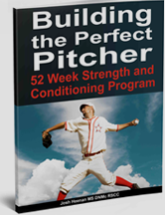Trace Increased Mound Velocity From 77 To 85 MPH In A Year With ATP
Trace Florio, remote client. Over the past year Trace’s mound velocity has jumped from 77 mph to 85 mph. Trace has put on 21 lb and increased his 90 mph formula numbers drastically in that time. Over the next coming months, we want Trace to continue to add bodyweight and improve his 90 mph formula numbers. This will allow him to add more velocity, strength, and stability.
October 2019 #90mphformula Metrics:
Height: 5’11”
Weight: 142 lb
Height/Weight Coefficient: 2.00
Deadlift: 255 lb x 1
Chin-up: 4 BW
Reverse lunge: 205 lb x 1
Long toss: 260 feet
Mound velocity: 77 mph
October 2020 #90mphformula Metrics:
Height: 5’11”
Weight: 163 lb
Height/Weight Coefficient: 2.30
Deadlift: 405 lb x 1
Chin-up: 11 BW
Reverse lunge: 255 lb x 2
Long toss: 305 feet
Mound velocity: 85 mph
To learn more about our remote programming services, visit our website by clicking here.
Jack Fox, Lander University Baseball, +4MPH In Four Months
Jack has been absolutely killing it since starting remote programming. I love how Jack, a Senior at Lander University, attacks his training in-season and leaves no stone unturned to make his ambitions to play at a professional level a reality.
As a Futures League All-Star, Jack has struck out a league-leading 55 batters in 47.2 innings with a 3.02 ERA.
Jack says, “Since starting with Advanced Therapy and Performance and Dr. Heenan months ago, I’ve packed on mass in all the right places. I’m throwing harder, my breaking stuff is breaking more than ever, my command has improved, and I’ve been having little to no arm soreness after 100+ pitches per outing. I came into the program with groin and hamstring problems, and both of them have disappeared.”
April 2019 #90mphformula Metrics:
Deadlift: 365 x 1
Chin Up: 10 BW
Reverse Lunge: 185 x 1
Long Toss: 350 feet
Bodyweight: 198 lbs
Mound Velocity: 89mph
July 2019 #90mphformula Metrics:
Deadlift: 405
Chin Up: 11 BW
Reverse Lunge: 225 x 1
Long Toss: 360+ feet
Bodyweight: 216 lbs
Mound Velocity: 93mph
To learn more about our remote programming services, visit our website by clicking here.
Ethan Doshi, University of Portland Infielder, Holistic Baseball Metric Improvements
Ethan says, “I was struggling to improve and couldn’t find anything that worked for me and was backed up by research, and then one day I was just scrolling on Instagram and I found your program and all of your posts made sense so I decided to work towards each of those metrics hoping it would increase velocity and make me a better athlete. What changed after I started working towards the formula was that I became a way better goal setter and felt a purpose to work harder every day knowing it was going to take time. What also helped was that my 60 time went from a 7.5 to a 6.9 in that time span too which to me seems correlated to parts of your program, and since I’m an infielder that helped a lot, also my exit velocity off the tee went from 84 to 92 with wood.”
March 2018 #90mphformula + Baseball Metrics:
Height: 5’9
Weight: 160lbs
Deadlift: 315lbs
Chin up: 190lbs (bw+30lbs)
Reverse lunge: 135×10 and 225×1
Long toss: 270ft
Run and gun: 86mph
Wood bat tee exit velocity: 84mph
60-yard dash: 7.5 seconds
April 2019 #90mphformula + Baseball Metrics:
Height: 5’10”
Weight: 177lbs
Deadlift: 445lbs
Chin up: 265lbs (bw+90lbs)
Reverse lunge: 225×10, 345×1
Long toss: 330ft
Run and gun: 94mph
Wood bat tee exit velocity: 92mph
60-yard dash: 6.9 seconds
Ethan’s insights are great, most specifically about goal setting. Having clear-cut metrics that are easy to quantify and strive for while directly impact performance and reducing injury risk factors allows each athlete to take ownership of their personal development. Accurate metrics to drive your program will elicit faster results allow you to make better decisions in training.
To learn more about our remote programming services, visit our website by clicking here.
Kaito Farquharson, Mayville State Baseball, Improved Run-and-Gun From 83 To 98 MPH In 3 Months
Kaito Came to me in August for a mechanical consult. What I found right away was how much more athletic he was with a 9oz ball and how his relative velocity was 6mph harder than with a 5oz ball. Kaito went to work and integrated some weighted ball progressions and uphill throwing drills over the next three months.
The video is from November when he hit a run and gun 98mph. Here is what I see in that video:
-Faster movement through the zone
-More athletic and level hip load
-Longer/more athletic stride
-Better timed arm action
However, there is still room to improve in two major areas:
-Efficient lead leg blocking
-Trail leg hip flexion
Much of Kaito’s mechanics have cleared up and he is now able to get much more velocity out of his body. The two breakdowns I mentioned above often happen when we see a big jump in velocity in a short time or strength is needed. For Kaito, I believe this is just a part of finding his new mechanics. Once he locks down the flat ground mechanics, I’ll want to see him progress to mound blends and then mound. This should take his 84mph fastball from August and get him to the low-90s quickly, then slowly tick up to the mid-90s as his current run and gun shows.
To learn more about our remote programming services, visit our website by clicking here.
How To Stop UCL Injuries: The 90MPH Formula
Those familiar with my work know I believe we can stop much of the UCL epidemic with proper screening, training, and logical progressions for athletes.

Camp, C. L., Conte, S., D’Angelo, J., & Fealy, S. (2017). Epidemiology of Ulnar Collateral Ligament Reconstruction in Major and Minor League Baseball Pitchers: Comprehensive Report on 1,313 Cases. Orthopaedic Journal of Sports Medicine, 5(7 suppl6).
Looking at the current research on valgus stress levels that the ulnar collateral ligament is up to 3 times weaker than the amount of force is exerted on a throw with a baseball.
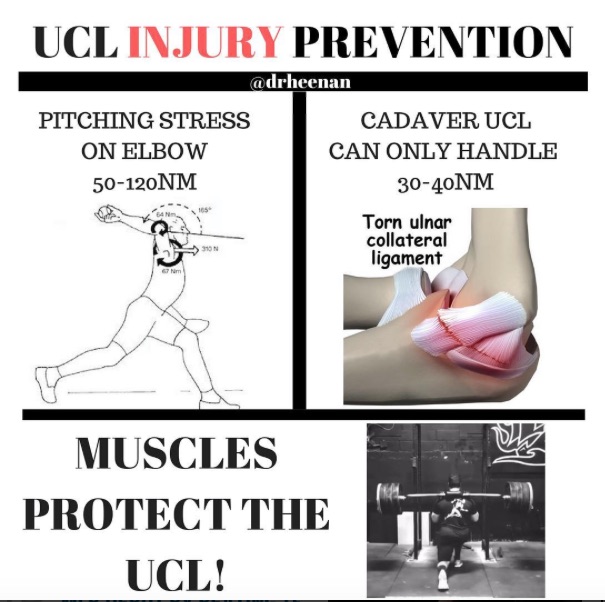
Based on our current understanding that a UCL cannot alone handle the force that throwing a baseball puts on it, we can make the case for muscular size and strength (within the specificity of the throwing motion) as main factors that protect the UCL from being strained or torn.
With 1100 baseball players having tested the criteria of the 90MPH Formula and only having 2 reported cases where an athlete could hit the metrics of the formula and needed UCL reconstruction (worth noting neither of these were our athletes local or remote clients). We have had close to 50 as of this post that reported unable to hit the parameters and had UCL reconstruction. Although the collection of the data was not done in a formalize setting, we are working on a formalized study so we can draw better correlations with quality research.

With all of these data points, we can start to draw correlations:⠀
-If you can hit the metrics, you can throw 90mph (or harder).
-If you can’t hit the metrics but can throw 90mph, you are exponentially more likely for an elbow or shoulder injury (UCL surgery most often reported).
⠀
Correlation to increased velo (in order):
1) bodyweight
2) reverse lunge
3) chin-up
4) deadlift
⠀
Correlation to decrease risk of injury (in order):
1) chin-up
2) reverse lunge
3) deadlift
4) bodyweight
⠀
My current thoughts:
-Long toss is still an underrated tool.
-Weighted balls should be used minimally prior to mastering a reverse lunge with your bw on the bar and 10 perfect bodyweight chin-ups.
-Optimal bodyweight is 2.75-3.25 x height in inches
-A 1.5x bodyweight reverse lunge is likely a replacement for 10 reps with bodyweight on the bar.
-Position players that reverse lunge 1.75x bodyweight (1rm) can run a 6.5 or less if they incorporate hill sprints and plyos as they are reaching those levels of strength.
-PO don’t sprint enough to have those strength gains carry over to elite level speed.
-Reverse lunges seem to be HIGHLY correlated to mound velocity, exit velocity, and 10/20/40/60 yard dash times.
-People seem to think I only like reverse lunges which is untrue. There are a ton of ways to increase your reverse lunge. Use what you need to get the reverse lunge to increase.
-Squatting (esp a true box squat) offer a ton of pros to getting you stronger and more athletic, they just don’t correlate to increased velo or decreased sprint times as well as lunges.
-Most high level athletes can achieve many of these numbers with one solid year of training year round. And yes, if you are not training year round I think you are going to spin your wheels for most of your career.
-Deadlift doesn’t seem to correlate well to injury prevention, but I do see a great value for it in terms of force production and adapted muscle mass. However, a 600lb deadlift doesn’t mean you should throw 110mph.
We may not have all the answers, but these correlations should allow athletes, coaches, and parents to utilize the above information in a progressive manner to start to reduce the UCL surgery epidemic we are seeing.
YOU MUST EARN THE RIGHT TO THROW HARD AND STAY HEALTHY!
Progressing the Reverse Lunge for Improved Performance
Guest post written by Brian Donofrio, C.S.C.S.
When working with athletes (especially our baseball guys), I’ve found the reverse lunge to be one of the best bang for your buck exercises we do in the weight room. It’s great for teaching proper loading of the hips, core control through the sagittal, frontal and transverse planes, as well as building stability, strength and power in a lunge pattern. And the carry over to sport is huge. Whether the athlete is running, throwing, or swinging, developing both stability and strength in the reverse lunge will lead to huge success. And through proper progressions and coaching of the reverse lunge, we can set our guys up to be stronger, faster and more powerful athletes.



Once an athlete successfully learns how to complete a reverse lunge, the benefits are huge. Getting to that point, though, requires allocating the time needed to build a strong foundation for the athlete to be successful in the movement. I’ll go over how exactly we attack the reverse lunge and how we get our guys into great positions that lead to success on the field.
When teaching a reverse lunge, or any exercise for that matter, you need to perfect the athlete’s baseline for the movement before you can progress them and start loading it. For some advanced lifters, you might be able to show them a proper reverse lunge a few times and they immediately crush it. But more often than not we need to start from the ground up, and work our way to performing the reverse lunge.
½ Kneeling Position
For most of our guys, this baseline means just getting them into a perfect ½ kneeling position on the ground. We teach them to have a good amount of dorsiflexion and a positive shin angle in the front leg. In the trail leg we look for full hip extension, and the back ankle dorsiflexed with the toes driving into the ground. We get them set up with the ribs down with the chest tall, neck back and chin tucked. The basic cues we use are to engage the core, feel the hips, and drive the toe into the ground. Here they can understand where we want them to feel tension through lower level activation. It also gives us the benefit of using kinesthetic cues to get the athletes exactly where we want them to be and give them more points of contact to reference and stabilize from. We might also incorporate some thoracic rotational work or overhead reaching in this position to train more dynamic stabilization in the position before moving forward. This allows the athlete to get a basic understanding of positioning and gain a kinesthetic sense for the position we’re asking them to get into.


Split Squat Hold
The next progression is to have the athlete perform a split squat hold (the bottom position of the reverse lunge). We’re looking for similar position as in the ½ kneeling position, except now the back knee is just off the ground, removing a point of contact to the ground. This makes it a more demanding position to be in and further challenges the athlete to build stability in the unilateral pattern. We’ll also incorporate proper breathing techniques to get them more comfortable in this position and improve their ability to hold it for a longer period of time. We typically like to work an athlete up to the point where they can hold that position for about 2 minutes/side. Just like with the ½ kneeling position, adding in rotational work or overhead reaching increases the transference to the field in terms of dynamic stabilization requirements.


Split Squat
Once the athlete is successful with the split squat hold, we can move on to a full split squat. Start with the athlete standing upright, with front and trail leg about 1 stride length apart with feet at hip width. The athlete then descends into the bottom position (the split squat hold described above). We have the athlete briefly pause here before driving back up. The key for carry over to the reverse lunge is to focus on the eccentric and isometric portion of the movement. This helps engrain the pattern and improves the athlete’s kinesthetic sense throughout. To further load this movement we may use a KB in a goblet or unilateral/bilateral front grip hold, a barbell in the front or back position or a safety bar to increase the demand of the tissues and further challenge the stability demands.
Reverse Lunge
As the athlete successfully completes the split squat, with the end positions and movement pattern performed to our standards, we can then start utilizing the reverse lunge in training. The athlete stands tall, with feet even about hip width apart. We’ll start by having the athlete take a step back and sink into the bottom position, holding there for a set amount of time.
The big cue here is to load the hips through the decent, building up tension and force to transfer through the ground on the concentric portion of the lift. We progress with a slight pause at the bottom followed by a powerful drive to the starting position. I coach my athletes to drive at an angle, using the hips to move forward to the starting position as if they are throwing a baseball to home plate or sprinting away from the line of scrimmage towards the end zone. We look to see that the athlete can maintain an upright position in the torso, and is able to stay balanced through the motion without leaning to one side or the other. Make sure the athlete is stabilizing through the core the for the entire lift, which is apparent if they can keep their weight shifted forward rather than swaying back in the bottom position or as they begin the concentric portion of the lift.
As the athlete becomes successful with the movement, we can load it in a number of ways, from a goblet hold with a kettlebell to a safety bar to a barbell. As long as they maintain good positioning and movement pattern, we can really challenge our athletes here.
Summary
If you want your athletes to keep progressing in the weight room, then you have to ensure they master the basics before attempting more complex movements. Give them the framework of proper position and movement patterns in more foundational exercises, and you can see a huge carry over. By establishing a strong foundation through positioning and proper progression, we set our athletes up for success not only in the weight room but on the field. Take time perfecting the basics, and the benefits will be huge for your athletes.
About the Author
 Brian is a strength coach based out of Advanced Therapy and Performance in Stamford, CT. He trains athletes from the high school to professional level, drawing upon his experiences in athletic performance and rehabilitation. He has worked extensively with collegiate athletics at his alma mater, the University of Connecticut, where he earned his B.S. in Exercise Science. After graduation, he worked with UConn Football Strength and Conditioning, as well as with a number of the school’s D1 athletic programs, including Men’s Soccer and Men’s Track and Field, as an undergrad. Brian holds his CSCS through the NSCA. You can find Brian on Instagram or at advancedtherapyperformance.com
Brian is a strength coach based out of Advanced Therapy and Performance in Stamford, CT. He trains athletes from the high school to professional level, drawing upon his experiences in athletic performance and rehabilitation. He has worked extensively with collegiate athletics at his alma mater, the University of Connecticut, where he earned his B.S. in Exercise Science. After graduation, he worked with UConn Football Strength and Conditioning, as well as with a number of the school’s D1 athletic programs, including Men’s Soccer and Men’s Track and Field, as an undergrad. Brian holds his CSCS through the NSCA. You can find Brian on Instagram or at advancedtherapyperformance.com
Want to Run a Faster 60-Yard Dash? START HERE
My right hand man Brian Donofrio did an outstanding presentation on the 40-yard dash for football players. After re-watching this webinar, I realized that he nails down so many points that we attack baseball players with it would be a disservice to not share it with you. This should be mandatory viewing for anyone wishing to play college or pro baseball.
If you have further questions please comment below in the comments sections and Brian or I will follow-up.
Josh’s notes on training the 40 or 60-yard dash:
- In training, we are most concerned with acceleration, not top speed. Teaching someone how to properly accelerate can drop their time .2 in a matter of one session.
- Muscle mass, broad jump, and reverse lunges are great indicators of acceleration potential.
- Stop wasting time running more than 100 yards. Get stronger and everything else works itself out.
- The fastest athletes/best movers I’ve every worked with have amazing abilities to bear crawl.
Shoulder Pain in Baseball Players
Anterior (front) shoulder pain is one of the most common complaints we get from all overhead athletes especially baseball players. This pain is often palpable at the origin of the bicep tendon. Although every case can have countless pathologies (such as labral tears, impingement, poor movement mechanics) causing the pain at the bicep tendon region, about 90% of the time we find that this pain is referred pain.
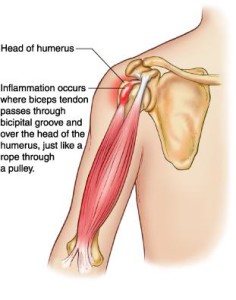
Referred pain is pain felt in a part of the body other than its actual source. Through my studies of Chinese Medicine, I can validate that many times the science and theory behind referred pain make little sense. Fortunately, pain that would be considered “bicipital tendonitis” is often very clear cut referred from the rotator cuff— most specifically the infraspinatus. The “X”s in the image below shows how the infraspinatus connects to the humerus (arm bone). Altered length, strength, movement mechanics, tissue quality or timing of the infraspinatus will throw off the mechanics of overhead movements.

To determine if this a true referred pain issue, we find the painful motion (usually reaching overhead) and have the athlete give us a number 1-10 (10 being terrible pain). After establishing a baseline for pain, we find tender points in the infraspinatus, apply firm pressure and retest the motion. This is uncomfortable for the athlete in the spot being pressed but often brings a 6-8/10 pain down to a 0-1. If that is the case, we have found the problem.
Fixing the soft tissue quality is usually done by aggressive treatment. This can be active release, cupping, Graston’s, or Gua Sha. Cupping has been the tool that gets the quickest and longest lasting results (see below). I believe this is the case because almost all therapeutic techniques are compressive in nature. Cupping offer a decompressive component often causing discoloration. Most athletes walk away pain-free in 1-2 treatments even if they have been suffering symptoms for years.
If you do not have access to a manual therapist, a lacrosse ball jammed into the infraspinatus often does the trick.
Are You Ready For a College Baseball Showcase?
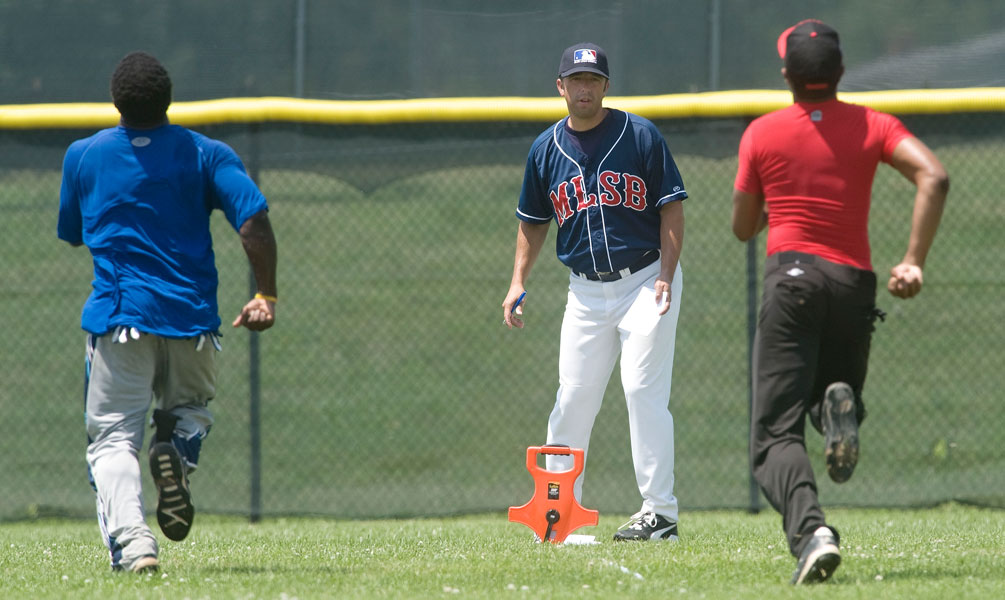
Summer time is almost here and for many high school players wishing to play college baseball this means showcase season. Showcases are a double edge sward. There are some outstanding showcases that allow you the opportunity to interact in with college coaches at schools you have interest in while getting a feel for their personality, skill set, and coaching style (yes, you are interviewing them as much as they are you). On the other end of the spectrum, there are factory style showcases that allow you and 500 other ball players just enough time to take 3 ground balls, 10 swings, and run a 60 all for the camera and then you are done for the day. Not the ideal situation for most.
I like to remind my athletes that a showcase is a job interview. A part of getting the job is absolutely how well you perform, but do you look the part? How well do you interact with the other players? What are your interactions with coaches? Do you look like you are having fun? Remember coaches are looking for people they want to have apart of their baseball family for 20-60 hours a week for 4-5 years!
ARE YOU READY FOR A SHOWCASE?
- Have you done skill work for baseball at least 2x per week outside of practice?Realize that practice is just the beginning. Routinely, our college guys take swings from 8-10pm on a Friday night. If you are not working on your skills while your competition is out partying on a regular basis you rarely have a leg up on them.
- Have you trained in the weight room at least 2x per week for the last 3-months?
If not, you are at a distinct disadvantage in regards to athletic potential and injury prevention. I believe for an athlete to even bother to go to a showcase he should have a solid 3-6 months minimum of organized training under their belt. If you don’t enjoy the process of getting better and training, you will likily not make a great college player.Check out this day in the life of a college baseball player article https://www.theodysseyonline.com/college-baseball-the-16-hour-day
- Have you recently taken a video of your 60-yard dash?I can’t tell you how many athletes tell me they run a 6.8-7.0 60-yard dash and when I ask them for a video of it they can only produce a video of them running an 8.2. Video does not lie. Get over the fact that you are not fast and figure out how to fix it.Unless you are a pitcher that throws mid 80s+ MPH or skill position guy that can legit hit the ball 400 feet, I would not recommend showing off your “skills” unless you run below a 7.5 60-yard dash.
- Have you recently taken a video of yourself… pitching, fielding, hitting?Pitchers —get on video with multiple shots at different angles— and at least one behind the backstop with a radar gun in view.Hitters —get a few views of you swinging and fielding/throwing.For all position, be honest with yourself. How athletic do you look? What do your mechanics and movements look like compared to the MLB version of you? Adjust accordingly.
- What’s your GPA?We all hear stories of guys who throw 90 MPH and rock a 2.0 GPA and he got a college scholarship, but let’s face it, you are probably not that guy— and that story was probably fabricated.Just like point #3, unless you are a pitcher throws mid 80s+ MPH or skill position guy that can legit hit the ball 400 feet, I would skip the showcase if your GPA is under a 2.5. Do yourself a favor and take summer classes to bring your GPA to that 3.0 range.Don’t think it really matters? Ask any DI program what their minimum team GPA and SAT scores need to be.
- Do you look the part?Coaches will say that looking the part is not that important as they are looking more for the skill and potential of the player but in my experience, this is incorrect. In fact, I often hear coaches state things like “look at that guy, he has obviously put in the work in the weight room” or “this kid swings well, but he needs to figure out where the kitchen is”.
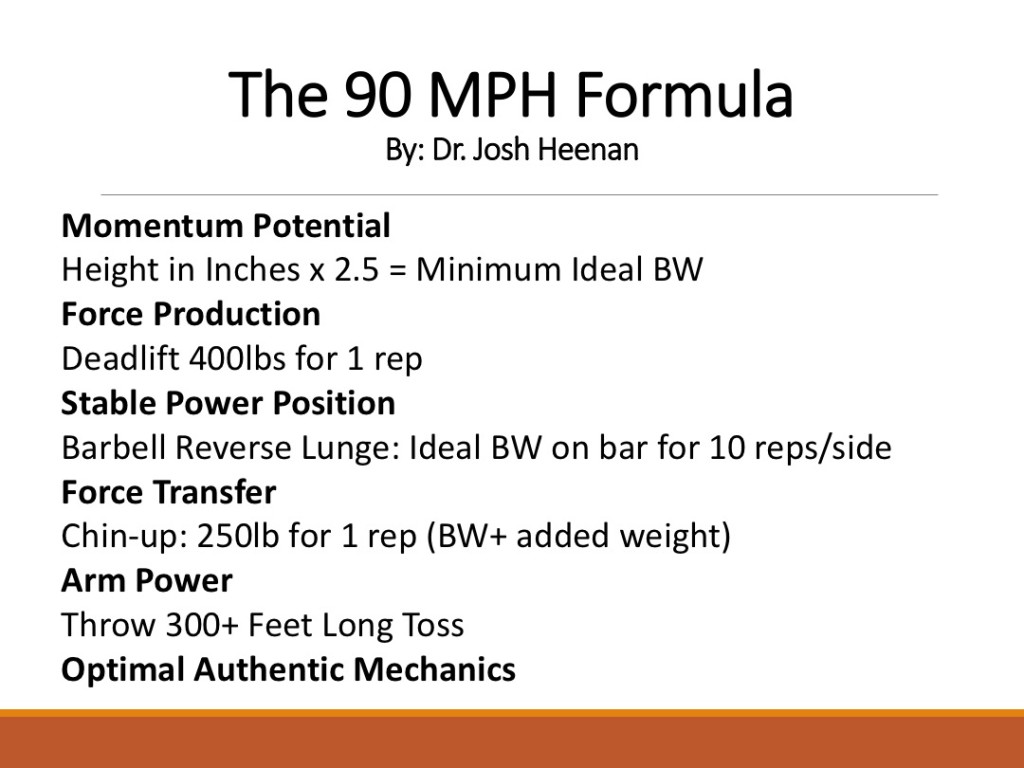 My 90 MPH formula for pitchers gives a guideline on weight I like to see our pitchers at. It get’s a little trickier for position players, but as a general rule, take your height in inches and multiple it by 2.5 and that is a good baseline for most athletes to start “looking the part”.
My 90 MPH formula for pitchers gives a guideline on weight I like to see our pitchers at. It get’s a little trickier for position players, but as a general rule, take your height in inches and multiple it by 2.5 and that is a good baseline for most athletes to start “looking the part”.
What other aspects do you think are important at your showcase? Where do you think you are lacking the most?
Leave your feedback below in the comments and I will gladly reply.
From No Offers to DI Baseball Player
I can’t get recruited
I get overlooked
My son doesn’t get fair playing time
They are prejudice because I’m too… short, skinny, slow, etc.
These are phrases we hear all the time.
The “I get over looked… I can’t… my coach…” garbage is just that, garbage. When presented with athletes or families that come saying those phrases we try to change word choice and outlook from day one. Many think they are going to be the next Bryce Harper, but let’s face it, the odds are highly against you.
To be fair, we are lucky to have many amazing athletes and families that are supportive and realistic with where they currently are and where they need to go to reach their goals.
Enter Tom Henderson
After working a showcase with Wayne Mazzoni, he suggested I reached out to Tom as he was a LHP senior in high school with good arm action, good grades, but just needed to get bigger and stronger to have a chance at the next level.
Tom was a whopping 135 lbs at 6’2″ with strength to match his frame— practically none.

Completely out of his comfort zone, Tom came to train 3-4x a week for the next 12 weeks along side pro, college, and signed high school ball players. Being able to do only 1 push-up on day one is pretty humbling when you have athletes tossing around 100lb dumbbells or 14-year olds doing 20 push-ups in a set.
But bust his butt day in and day out he did
After about 2 weeks we sat down and had our nutritional talk. We evaluated where he currently was with his eating and created a plan on how to add some serious size to his frame over the next 12 weeks. We implemented simple weekly check-ins to monitor progress, but attached some deterrents for each missed a weigh-in.
Tom soon felt what it was like to be truly “full”. The first weekly weigh-in he was up 5 lbs. Second week, another 4. Third week, another 4. For those 12 weeks, Tom treated eating like it was a full time job.
Those 12 weeks passed without a missed weigh-in and Tom was now tipping the scales at 170lbs. Along with his new found weight, his strength gains were impressive to say the least. Push-ups had become relatively easy and his deadlift was up over 100 lbs. Most importantly, Tom’s velocity on the mound had jumped.
Prior to his weight gain adventure, I promised Tom if he put in the work, I would vouch for him at his #1 prospective school, Marist College. Upon speaking with the coach I realized they had no more roster spots for the following year. Without any hesitation, Tom said he would end up going there when he was accepted and walk on. Little did he know that 6 weeks later I would get a call from that coach stating they just cut a handful of guys from there program and wanted to extend a roster spot for Tom for the coming year.
Fast forward to today
Tom is now a role player for his DI program and touts a .077 batting average against. Currently sitting at 185lbs with a fastball that nearly tops the 90mph mark. With a frame that can still handle adding another 30-40lbs and project him to add another 5-10 mph on his fastball and 3 more years of eligibility, Tom has a lot to look forward to.
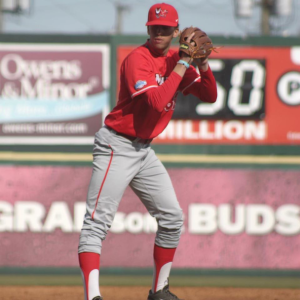
Without Josh’s expertise and connections I would not have had the opportunity to play baseball at Marist College. Josh, along with his terrific staff, have pushed me for two years, and have helped me gain a total of 60 lbs, 35 of those in my first 12 weeks of training. This weight has taken stress of my elbow and shoulder while allowing me to increase my velocity by upwards of 10 MPH, nearing 90 MPH. The key to our training is the focus on muscles and movements that put by body in better positions on the mound, which directly correlates to what you need to continue to succeed and play at the next level.
Are these the type of results you are looking for?
Email me for more information about our remote programming platform, go to https://advancedtherapyperformance.com/90mphformula/





